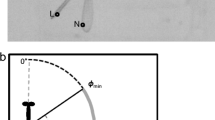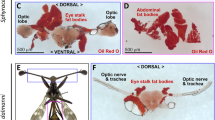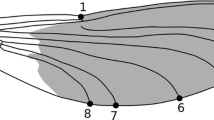Abstract
The eyes of stalk-eyed flies (Diopsidae) are positioned at the end of rigid peduncles projected laterally from the head. In dimorphic species the eye-stalks of males exceed the eye-stalks of females and can exceed body length. Eye-stalk length is sexually selected in males improving male reproductive success. We tested whether the long eye-stalks have a negative effect on free-flight and aerial turning behavior by analyzing the morphology and free-flight trajectories of male and female Cyrtodiopsis dalmanni. At flight posture the mass-moment-of-inertia for rotation about a vertical axis was 1.49-fold higher in males. Males also showed a 5% increase in wing length compared to females. During free-flight females made larger turns than males (54 ± 31.4 vs. 49 ± 36.2°, t test, P < 0.033) and flew faster while turning (9.4 ± 5.45 vs. 8.4 ± 6.17 cm s−1, ANOVA, P < 0.021). However, turning performance of both sexes overlapped, and turn rate in males even marginally exceeded turn rate in females (733 ± 235.3 vs. 685 ± 282.6 deg s−1, ANCOVA, P < 0.047). We suggest that the increase in eye-span does result in an increase in the mechanical requirements for aerial turning but that male C. dalmanni are capable of compensating for the constraint of longer eye-stalks during the range of turns observed through wingbeat kinematics and increased wing size.








Similar content being viewed by others
Abbreviations
- MOI:
-
Moment of inertia
References
Alighali MA (1984) Mating and ovipositional behavior of the stalk-eyed fly Diopsis macrophthalma on rice. Entoml Exp Appl 36:151–157
Baker RH, Wilkinson GS (2001) Phylogenetic analysis of sexual dimorphism and eye-span allometry in stalk-eyed flies (Diopsidae). Evolution 55:1373–1385
Bender JA, Dickinson MH (2006a) Visual stimulation of saccades in magnetically tethered Drosophila. J Exp Biol 209:3170–3182
Bender JA, Dickinson MH (2006b) A comparison of visual and haltere-mediated feedback in the control of body saccades in Drosophila melanogaster. J Exp Biol 209:4597–4606
Burkhardt D, de la Motte I (1983) How stalk-eyed flies eye stalk-eyed flies: observation and measurements of the eyes of Cyrtodiopsis whitei (Diopsidae, Diptera). J Comp Physiol A 151:407–421
Burkhardt D, de la Motte I (1988) Big “antlers” are favored: female choice in stalk-eyed flies (Dipter, Insecta), field collected harems and laboratory experiments. J Comp Physiol A 162:649–652
Buschbeck EK, Hoy RR (1998) Visual system of the stalk-eyed fly, Cyrtodiopsis quinqueguttata (Diopsidae, Diptera): an anatomical investigation of unusual eyes. J Neurobiol 37:449–468
Christianson SJ, Swallow JG, Wilkinson GS (2005) Rapid evolution of postzygotic reproductive isolation in stalk-eyed flies. Evolution 59:849–857
Collett TS, Land MF (1975) Visual control of flight behaviour in the hoverfly Syritta pipiens L. J Comp Physiol A 99:1–66
Cotton S, Fowler K, Pomiankowski A (2004) Condition dependence of sexual ornament size and variation in the stalk-eyed flies Cyrtodiopsis dalmanni (Diptera: Diopsidae). Evolution 58:1038–1046
David P, Bjorksten T, Fowler K, Pomiankowski A (2000) Condition dependent signaling of genetic variation in stalk-eyed flies. Nature 406:186–188
Dickinson MH (2005) The initiation and control of rapid flight maneuvers in fruit flies. Integr Comp Biol 45:274–281
Dudley R (2002) Mechanisms and implications of animal flight maneuverability. Integr Comp Biol 42:135–140
Ellington CP (1984) The aerodynamics of hovering insect flight II. Morphological parameters. Philos Trans R Soc Lond B 305:17–40
Fox EA (1967) Mechanics. Harper & Row, NY
Fry SN, Bichsel M, Muller P, Robert D (2000) Tracking of flying insects using pan-tilt cameras. J Neuro Sci Methods 101:59–67
Fry SN, Sayaman R, Dickinson MH (2003) The aerodynamics of free-flight maneuvers in Drosophila. Science 300:495–498
Frye MA, Tarsitano M, Dickinson MH (2003) Odor localization requires visual feedback during free flight in Drosophila melanogaster. J Exp Biol 206:843–855
Götz KG, Wandel U (1984) Optomotor control of the force of flight in Drosophila and Musca. Biol Cyber 51:135–139
Heide G, Götz GK (1996) Optomotor control of course and altitude in Drosophila melanogaster is correlated with distinct activities of at least three pairs of flight steering muscles. J Exp Biol 199:1711–1726
Heisenberg M, Wolf R (1979) On the fine structure of yaw torque in visual flight orientation of Drosophila melanogaster. J Comp Physiol A 130:113–130
Knell RJ, Fruhauf N, Norris KA (1999) Conditional expression of a sexually selected trait in the stalk-eyed fly Diasemopsis aethiopica. Ecol Entomol 24:323–328
Land MF (1999) Motion and vision: why animals move their eyes. J Comp Physiol A 185:341–352
Land MF, Collett TS (1974) Chasing behaviour of houseflies (Fannia canicularis). J Comp Physiol A 89:331–357
Land MF, Nilsson D-E (2002) Animal eyes. Oxford University Press, New York
Marden JH (1987) Maximum lift production during takeoff in flying animals. J Exp Biol 130:235–258
Mayer M, Vogtmann K, Bausenwein B, Wolf R, Heisenberg M (1988) Flight control during “free yaw turns” in Drosophila melanogaster. J Comp Physiol A 163:389–399
Panhuis TM, Wilkinson GS (1999) Exaggerated male eye span influences contest outcome in stalk eyed flies (Diopsidae). Behav Ecol Sociobiol 46:221–227
Rayner JMV, Aldridge HDJ (1985) Three-dimensional reconstruction of animal flight paths and the turning flight of microchiropteran bats. J Exp Biol 118:247–265
Reguera P, Pomiankowski A, Fowler K, Chapman T (2004) Low cost of reproduction in female stalk-eyed flies, Cyrtodiopsis dalmanni. J Insect Physiol 50:103–108
Schilstra C, van Hateren JH (1999) Blowfly flight and optic flow. I. Thorax kinematics and flight dynamics. J Exp Biol 202:1481–1490
Schilstra C, Van Hateren JH (1998) Stabilizing gaze in flying blowflies. Nature 395:654
Shilito FJ (1971) Dimorphism in flies with stalked eyes. Zool J Linn Soc 50:297–305
Swallow JG, Wilkinson GS, Marden JH (2000) Aerial performance of stalk-eyed flies that differ in eye span. J Comp Physiol B 170:481–487
Swallow JG, Wallace LE, Christianson SJ, Johns PM, Wilkinson GS (2005) Genetic divergence does not predict change in ornament expression among populations of stalk-eyed flies. Mol Ecol 14:3787–3800
Tammero LF, Dickinson MH (2002a) The influence of visual landscape on the free flight behavior of the fruit fly Drosophila melanogaster. J Exp Biol 205:327–343
Tammero LF, Dickinson MH (2002b) Collision-avoidance and landing responses are mediated by separate pathways in the fruit fly, Drosophila melanogaster. J Exp Biol 205:2785–2798
Wagner H (1986) Flight performance and visual control of flight of the free flying housefly (Musca domestica L.) III. Interaction between angular movements induced by wide and small field stimuli. Philos Trans R Soc Lond B 312:581–595
Weis-Fogh T (1973) Quick estimates of flight fitness in hovering animals, including novel mechanisms for lift production. J Exp Biol 59:169–230
Wilkinson GS (1993) Artificial sexual selection alters allometry in the stalk-eyed fly Cyrtodiopsis dalmanni (Diptera: Diopsidae). Genet Res Camb 62:213–222
Wilkinson GS, Dobson GN (1997) Function and evolution of antlers and eye stalks in flies. In: Choe J, Crespi B (eds) The evolution of mating systems in insects and arachnids. Cambridge University Press, New York, pp 310–328
Wilkinson GS, Reillo PR (1994) Female choice response to artificial selection on an exaggerated male trait in a stalk-eyed fly. Proc R Soc Lond B 255:1–6
Wilkinson GS., Kahler H, Baker RH (1998) Evolution of female mating preference in stalk-eyed flies. Behav Ecol 9:525–533
Wilkinson GS, Swallow JG, Christensen SJ, Madden K (2003) Phylogeography of sex ratio and multiple mating in stalk-eyed flies from Southeast Asia. Genetica 117:37–46
Wright TF, Johns PM, Walters JR, Lerner AP, Swallow JG, Wilkinson GS (2004) Microsatellite variation among divergent populations of stalk-eyed flies, genus Cyrtodiopsis. Genet Res Camb 84:27–40
Zeil J (1983) Sexual dimorphism in the visual system of flies: the divided brain of male Bibionidae (Diptera). Cell Tissue Res 229:591–610
Acknowledgments
The authors are grateful for the help provided by G. S. Wilkinson in establishing C. dalmnni population in our lab. S. N. Fry helped in configuration and troubleshooting of the tracking system. D. Jolkowski, A. Egge, H. Moline, and T. Eviatar-Ribak helped in fly care and in the experiments. We thank Y. Brant for discussions on statistical analysis. The work was funded by NSF-grant No. IOB0448060.
Author information
Authors and Affiliations
Corresponding author
Rights and permissions
About this article
Cite this article
Ribak, G., Swallow, J.G. Free flight maneuvers of stalk-eyed flies: do eye-stalks affect aerial turning behavior?. J Comp Physiol A 193, 1065–1079 (2007). https://doi.org/10.1007/s00359-007-0259-1
Received:
Revised:
Accepted:
Published:
Issue Date:
DOI: https://doi.org/10.1007/s00359-007-0259-1




